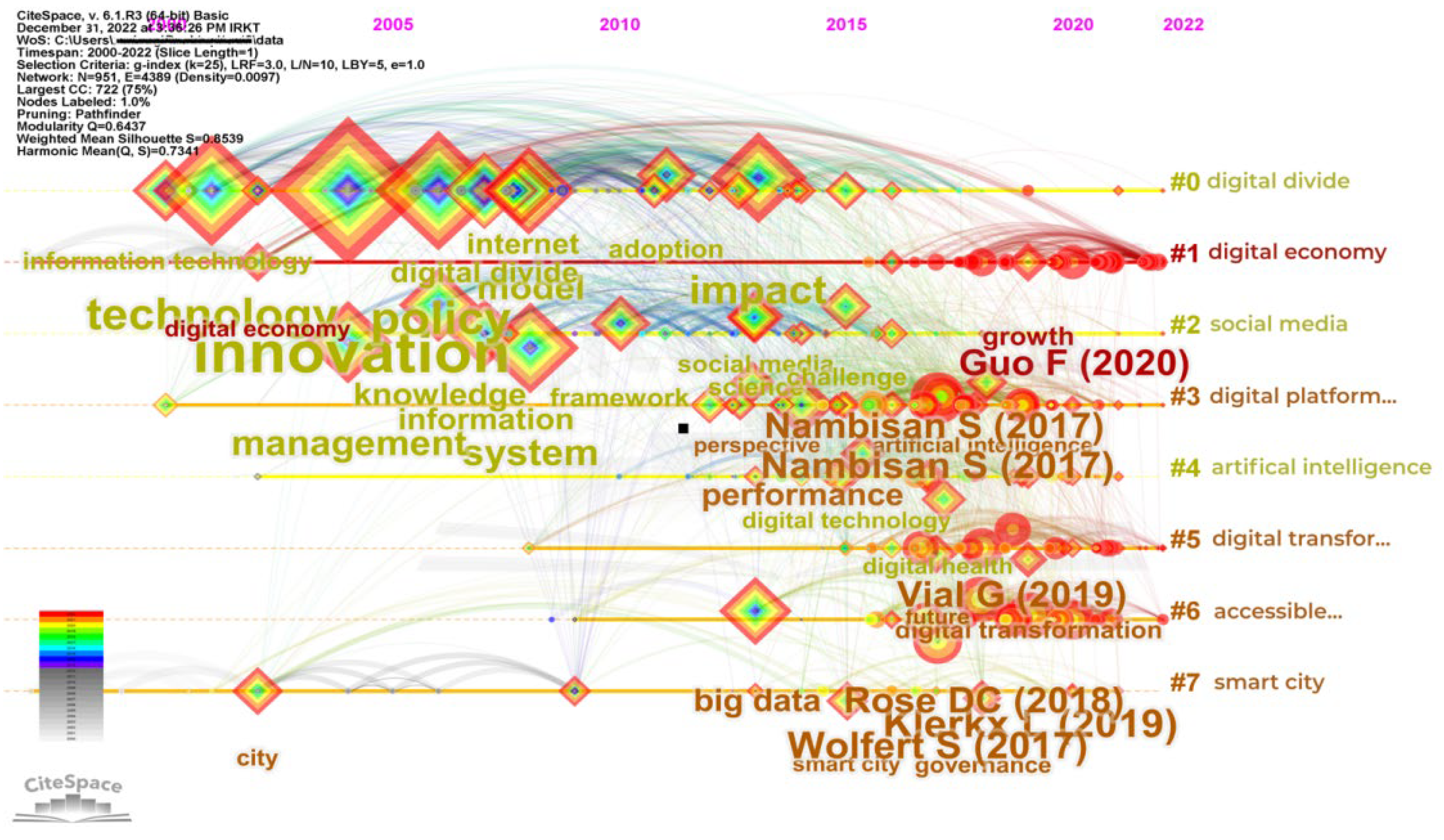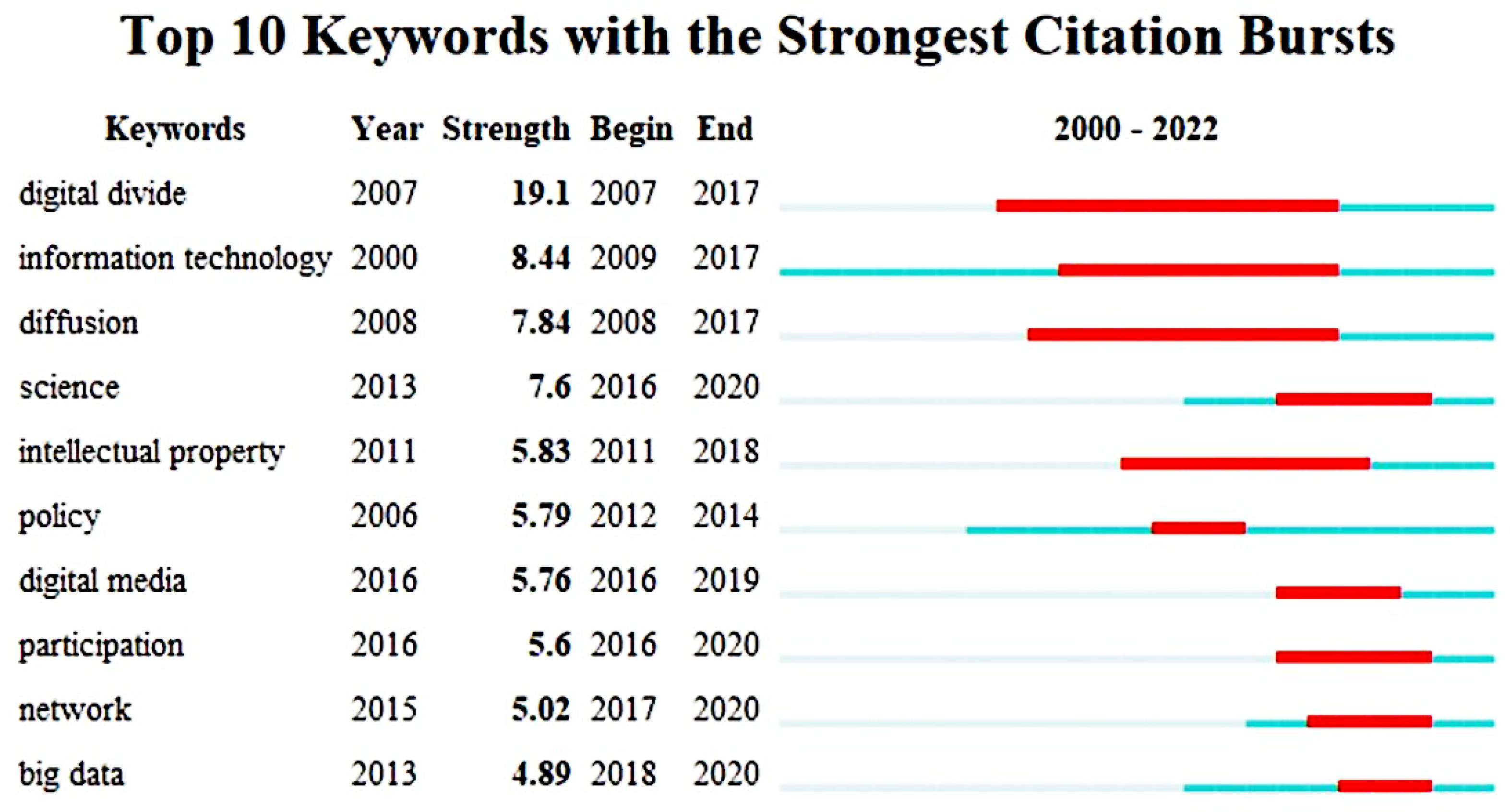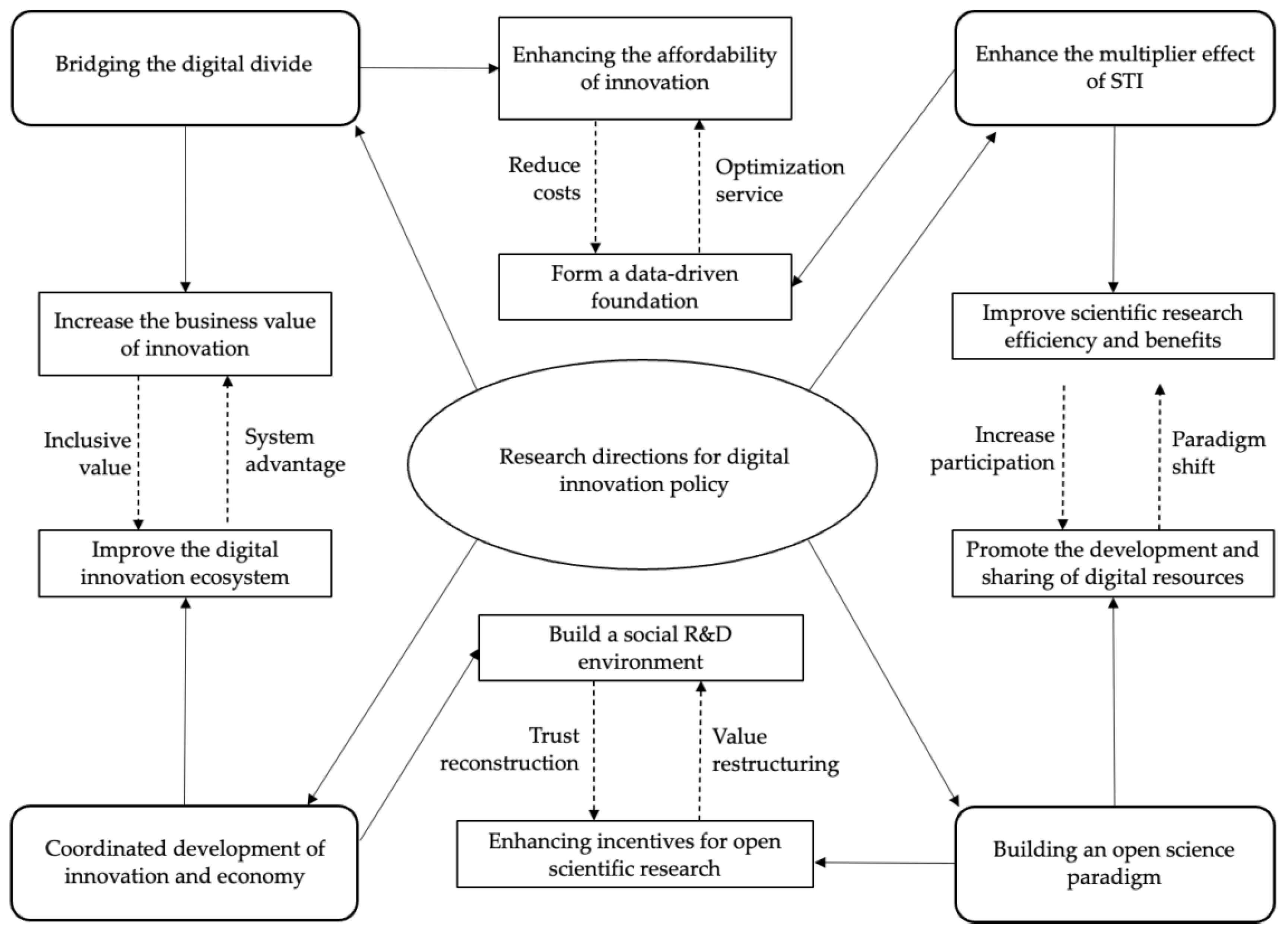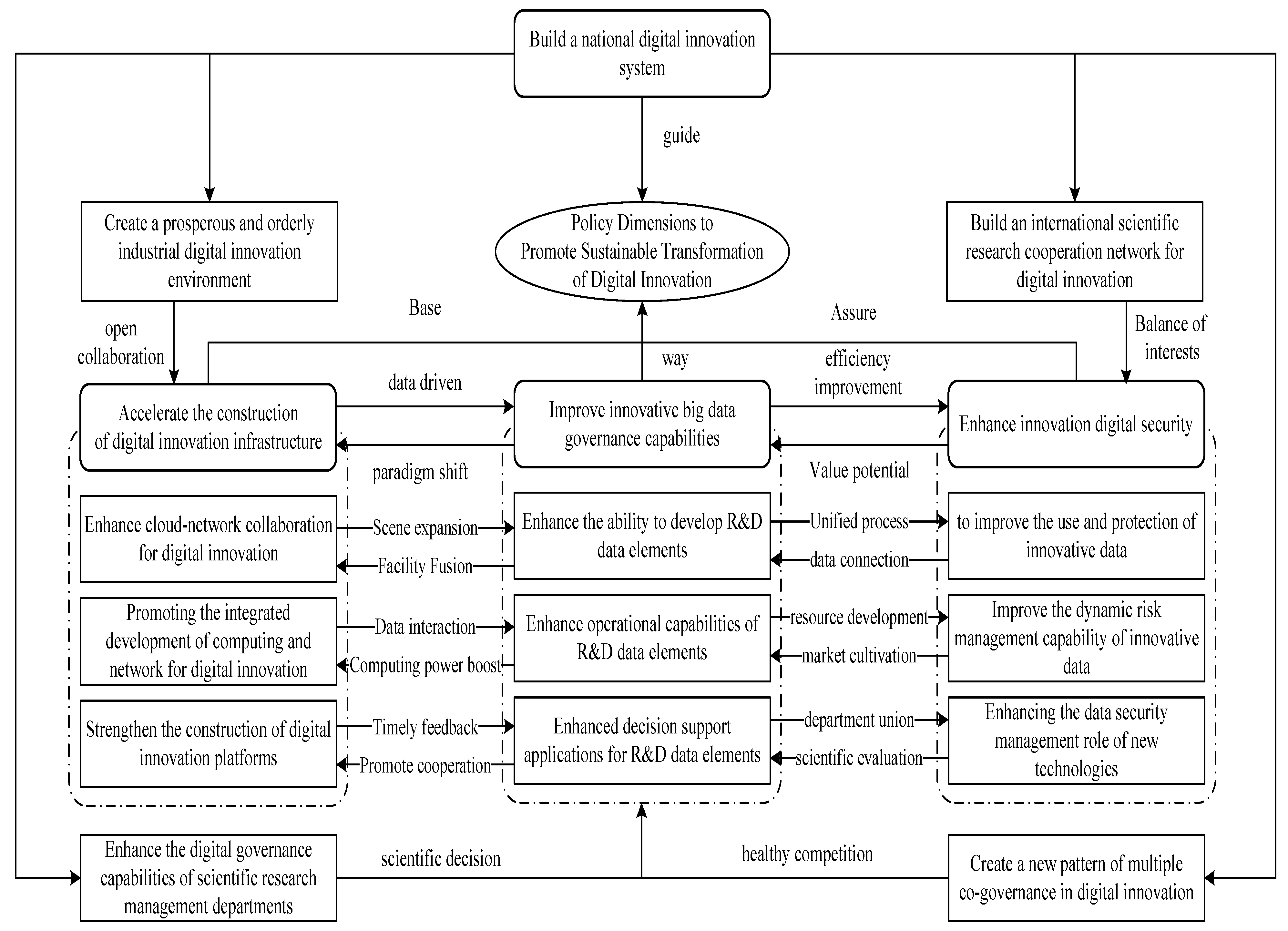A Review of Policy Framework Research on Promoting Sustainable Transformation of Digital Innovation
Abstract
1. Introduction
2. Co-Citation Analysis of Documents Based on Citespace
2.1. Overall Rresearch Progress
2.2. Research Trends and Hotspots
2.3. Research Directions of Digital Innovation Policy
3. The Policy Demand of the Sustainable Transformation Process of Digital Innovation
3.1. Create R&D Opportunities and Reduce R&D Costs
3.2. Optimize R&D Organization and Improve R&D Efficiency
3.3. Build Ecological Advantages and Support R&D Decisions
3.4. Promote Reform through Evaluation and Improve R&D Governance
4. The Policy Orientation to Promote the Sustainable Transformation of Digital Innovation
4.1. Knowledge Creation That Encourages Digital Innovation
4.2. Expand the Enabling Application of Digital Innovation
4.3. Coordinate the Collaborative Promotion of Digital Innovation
4.4. Strengthen the Normative Governance of Digital Innovation
5. Policy Dimensions to Promote Sustainable Transformation of Digital Innovation
5.1. Guiding the Construction of a National Digital Innovation System
5.2. Speeding Up the Infrastructure of Digital Innovation
5.3. Improve the Governance Ability of Innovative Big Data
5.4. Enhance Security for Digital Innovation
6. Research Conclusions
Author Contributions
Funding
Data Availability Statement
Acknowledgments
Conflicts of Interest
References
- Nambisan, S.; Lyytinen, K.; Majchrzak, A.; Song, M. Digital Innovation Management: Reinventing Innovation Management Research in a Digital World. MIS Q. 2017, 41, 223–238. [Google Scholar] [CrossRef]
- Liu, Y.; Dong, J.; Ying, Y.; Jiao, H. Status and digital innovation: A middle-status conformity perspective. Technol. Forecast. Soc. Chang. 2021, 168, 120781. [Google Scholar] [CrossRef]
- Kohli, R.; Melville, N.P. Digital innovation: A review and synthesis. Inf. Syst. J. 2019, 29, 200–223. [Google Scholar] [CrossRef]
- Nambisan, S.; Wright, M.; Feldman, M. The digital transformation of innovation and entrepreneurship: Progress, challenges and key themes. Res. Policy 2019, 48, 103773. [Google Scholar] [CrossRef]
- Gao, P.; Wu, W.; Yang, Y. Discovering Themes and Trends in Digital Transformation and Innovation Research. J. Theor. Appl. Electron. Commer. Res. 2022, 17, 1162–1184. [Google Scholar] [CrossRef]
- Van Veldhoven, Z.; Vanthienen, J. Digital transformation as an interaction-driven perspective between business, society, and technology. Electron. Mark. 2022, 32, 629–644. [Google Scholar] [CrossRef]
- Liu, Y.; Dong, J.; Mei, L.; Shen, R. Digital innovation and performance of manufacturing firms: An affordance perspective. Technovation 2023, 119, 102458. [Google Scholar] [CrossRef]
- Sgroi, F.; Marino, G. Environmental and digital innovation in food: The role of digital food hubs in the creation of sustainable local agri-food systems. Sci. Total Environ. 2022, 810, 152257. [Google Scholar] [CrossRef]
- Lyytinen, K. Innovation logics in the digital era: A systemic review of the emerging digital innovation regime. Innovation 2022, 24, 13–34. [Google Scholar] [CrossRef]
- Guo, F.; Bo, Q.; Tong, X.; Zhang, X. A paradoxical view of speed and quality on operational outcome: An empirical investigation of innovation in high-tech small and medium-sized enterprises. Int. J. Prod. Econ. 2020, 229, 107780. [Google Scholar] [CrossRef]
- Nambisan, S. Digital Entrepreneurship: Toward a Digital Technology Perspective of Entrepreneurship. Entrep. Theory Pract. 2017, 41, 1029–1055. [Google Scholar] [CrossRef]
- Vial, G. Understanding digital transformation: A review and a research agenda. J. Strateg. Inf. Syst. 2019, 28, 118–144. [Google Scholar] [CrossRef]
- Rose, D.C.; Chilvers, J. Agriculture 4.0: Broadening Responsible Innovation in an Era of Smart Farming. Front. Sustain. Food Syst. 2018, 2, 87. [Google Scholar] [CrossRef]
- Klerkx, L.; Jakku, E.; Labarthe, P. A review of social science on digital agriculture, smart farming and agriculture 4.0: New contributions and a future research agenda. NJAS Wagening. J. Life Sci. 2019, 90, 100315. [Google Scholar] [CrossRef]
- Wolfert, S.; Ge, L.; Verdouw, C.; Bogaardt, M. Big data in smart farming—A review. Agric. Syst. 2017, 153, 69–80. [Google Scholar] [CrossRef]
- Dennehy, D.; Schmarzo, B.; Sidaoui, M. Organising for AI-powered innovation through design: The case of Hitachi Vantara. Int. J. Technol. Manag. 2022, 88, 312–334. [Google Scholar] [CrossRef]
- Curran, D. Risk, innovation, and democracy in the digital economy. Eur. J. Soc. Theory 2018, 21, 207–226. [Google Scholar] [CrossRef]
- Sultana, S.; Akter, S.; Kyriazis, E.; Wamba, S.F. Architecting and Developing Big Data-Driven Innovation (DDI) in the Digital Economy. J. Glob. Inf. Manag. 2021, 29, 165–187. [Google Scholar] [CrossRef]
- Konstantopoulos, G.; Koumoulos, E.P.; Charitidis, C.A. Digital Innovation Enabled Nanomaterial Manufacturing; Machine Learning Strategies and Green Perspectives. Nanomaterials 2022, 12, 2646. [Google Scholar] [CrossRef]
- Henfridsson, O.; Nandhakumar, J.; Scarbrough, H.; Panourgias, N. Recombination in the open-ended value landscape of digital innovation. Inf. Organ. 2018, 28, 89–100. [Google Scholar] [CrossRef]
- Karunakaran, A. In Cloud We Trust? Co-opting Occupational Gatekeepers to Produce Normalized Trust in Platform-Mediated Interorganizational Relationships. Organ. Sci. 2022, 33, 1188–1211. [Google Scholar] [CrossRef]
- Geissinger, A.; Laurell, C.; Sandström, C.; Eriksson, K.; Nykvist, R. Digital entrepreneurship and field conditions for insti-tutional change–Investigating the enabling role of cities. Technol. Forecast. Soc. 2019, 146, 877–886. [Google Scholar] [CrossRef]
- Sassanelli, C.; Terzi, S. Building the Value Proposition of a Digital Innovation Hub Network to Support Ecosystem Sustain-ability. Sustainability 2022, 14, 11159. [Google Scholar] [CrossRef]
- Bican, P.M.; Brem, A. Digital business model, digital transformation, digital entrepreneurship: Is there a sustainable “digital”? Sustainability 2020, 12, 5239. [Google Scholar] [CrossRef]
- Hodapp, D.; Hanelt, A. Interoperability in the era of digital innovation: An information systems research agenda. J. Inf. Technol. 2022, 37, 407–427. [Google Scholar] [CrossRef]
- Nambisan, S. Digital innovation and international business. Innovation 2022, 24, 86–95. [Google Scholar] [CrossRef]
- Campagnolo, G.M.; Nguyen, H.T.; Williams, R. The temporal dynamics of technology promises in government and industry partnerships for digital innovation: The case of the Copyright Hub. Technol. Anal. Strat. Manag. 2019, 31, 972–985. [Google Scholar] [CrossRef]
- Hevner, A.; Gregor, S. Envisioning entrepreneurship and digital innovation through a design science research lens: A matrix approach. Inf. Manag. 2020, 59, 103350. [Google Scholar] [CrossRef]
- Wang, P. Connecting the Parts with the Whole: Toward an Information Ecology Theory of Digital Innovation Ecosystems. MIS Q. 2021, 45, 397–422. [Google Scholar] [CrossRef]
- Kolloch, M.; Dellermann, D. Digital innovation in the energy industry: The impact of controversies on the evolution of in-novation ecosystems. Technol. Forecast. Soc. 2018, 136, 254–264. [Google Scholar] [CrossRef]
- Bonina, C.; López-Berzosa, D.; Scarlata, M. Social, commercial, or both? An exploratory study of the identity orientation of digital social innovations. Inf. Syst. J. 2021, 31, 695–716. [Google Scholar] [CrossRef]
- Yousaf, Z.; Radulescu, M.; Sinisi, C.I.; Serbanescu, L.; Păunescu, L.M. Towards Sustainable Digital Innovation of SMEs from the Developing Countries in the Context of the Digital Economy and Frugal Environment. Sustainability 2021, 13, 5715. [Google Scholar] [CrossRef]
- Rizk, A.; Elragal, A. Data science: Developing theoretical contributions in information systems via text analytics. J. Big Data 2020, 7, 7. [Google Scholar] [CrossRef]
- Boudreau, K.J.; Jeppesen, L.B.; Miric, M. Profiting from digital innovation: Patents, copyright and performance. Res. Policy 2022, 51, 104477. [Google Scholar] [CrossRef]
- Whyte, J. How digital information transforms project delivery models. Proj. Manag. J. 2019, 50, 177–194. [Google Scholar] [CrossRef]
- Pershina, R.; Soppe, B.; Thune, T.M. Bridging analog and digital expertise: Cross-domain collaboration and boundary-spanning tools in the creation of digital innovation. Res. Policy 2019, 48, 103819. [Google Scholar] [CrossRef]
- Hinings, B.; Gegenhuber, T.; Greenwood, R. Digital innovation and transformation: An institutional perspective. Inf. Organ. 2018, 28, 52–61. [Google Scholar] [CrossRef]
- Senyo, P.K.; Liu, K.; Effah, J. Digital business ecosystem: Literature review and a framework for future research. Int. J. Inf. Manag. 2019, 47, 52–64. [Google Scholar] [CrossRef]
- Trocin, C.; Hovland, I.V.; Mikalef, P.; Dremel, P. How Artificial Intelligence affords digital innovation: A cross-case analysis of Scandinavian companies. Technol. Forecast. Soc. Chang. 2021, 173, 121081. [Google Scholar] [CrossRef]
- Vendrell-Herrero, F.; Gomes, E.; Opazo-Basaez, M.; Bustinza, O.F. Knowledge acquisition throughout the lifecycle: Product and industry learning frameworks. J. Knowl. Manag. 2022, 26, 1633–1647. [Google Scholar] [CrossRef]
- Arias-Pérez, J.; Vélez-Jaramillo, J. Ignoring the three-way interaction of digital orientation, Not-invented-here syndrome and employee’s artificial intelligence awareness in digital innovation performance: A recipe for failure. Technol. Forecast. Soc. 2022, 174, 121305. [Google Scholar] [CrossRef]
- Sánchez-Cartas, J.M. Intellectual property and taxation of digital platforms. J. Econ. 2021, 132, 197–221. [Google Scholar] [CrossRef]
- Steinhauser, S.; Doblinger, C.; Hüsig, S. The Relative Role of Digital Complementary Assets and Regulation in Discontinuous Telemedicine Innovation in European Hospitals. J. Manag. Inf. Syst. 2020, 37, 1155–1183. [Google Scholar] [CrossRef]
- Alvarado-Vargas, M.J.; Inamanamelluri, T.; Zou, Q. Product attributes and digital innovation performance: The importance of country and firm level supporting environment. Int. J. Technol. Manag. 2020, 82, 206–226. [Google Scholar] [CrossRef]
- Del Giudice, M.; Scuotto, V.; Papa, A.; Tarba, S.Y.; Bresciani, S.; Warkentin, M. A self-tuning model for smart manufacturing SMEs: Effects on digital innovation. J. Prod. Innovat. Manag. 2021, 38, 68–89. [Google Scholar] [CrossRef]
- Gawer, A. Digital platforms and ecosystems: Remarks on the dominant organizational forms of the digital age. Innovation 2022, 24, 110–124. [Google Scholar] [CrossRef]
- Jafari-Sadeghi, V.; Garcia-Perez, A.; Candelo, E.; Couturier, J. Exploring the impact of digital transformation on technology entrepreneurship and technological market expansion: The role of technology readiness, exploration and exploitation. J. Bus. Res. 2021, 124, 100–111. [Google Scholar] [CrossRef]
- Saadatmand, F.; Lindgren, R.; Schultze, U. Configurations of platform organizations: Implications for complementor engagement. Res. Policy 2019, 48, 103770. [Google Scholar] [CrossRef]
- Huang, J.; Henfridsson, O.; Liu, M.J. Extending Digital Ventures through Templating. Inf. Syst. Res. 2022, 33, 285–310. [Google Scholar] [CrossRef]
- Dong, J.Q. Moving a mountain with a teaspoon: Toward a theory of digital entrepreneurship in the regulatory environment. Technol. Forecast. Soc. 2019, 146, 923–930. [Google Scholar] [CrossRef]
- Wiener, M.; Mähring, M.; Remus, U.; Saunders, C.; Cram, W.A. Moving IS Project Control Research into the Digital Era: The “Why” of Control and the Concept of Control Purpose. Inf. Syst. Res. 2019, 30, 1387–1401. [Google Scholar] [CrossRef]
- Magnusson, J.; Koutsikouri, D.; Päivärinta, T. Efficiency creep and shadow innovation: Enacting ambidextrous IT Governance in the public sector. Eur. J. Inf. Syst. 2020, 29, 329–349. [Google Scholar] [CrossRef]
- Ayre, M.; Mc Collum, V.; Waters, W.; Samson, P.; Curro, A.; Nettle, R.; Paschen, J.; King, B.; Reichelt, N. Supporting and practising digital innovation with advisers in smart farming. NJAS-Wagen J. Life Sci. 2019, 90, 100302. [Google Scholar] [CrossRef]
- Tate, M.; Bongiovanni, I.; Kowalkiewicz, M.; Townson, P. Managing the “Fuzzy front end” of open digital service innovation in the public sector: A methodology. Int. J. Inf. Manag. 2018, 39, 186–198. [Google Scholar] [CrossRef]
- Thorén, C.; Ågerfalk, P.J.; Rolandsson, B. Voicing the Puppet: Accommodating Unresolved Institutional Tensions in Digital Open Practices. Organ. Stud. 2018, 39, 923–945. [Google Scholar] [CrossRef]
- Thomas, L.D.W.; Tee, R. Generativity: A systematic review and conceptual framework. Int. J. Manag. Rev. 2022, 24, 255–278. [Google Scholar] [CrossRef]
- Haefner, L.; Sternberg, R. Spatial implications of digitization: State of the field and research agenda. Geogr. Compass 2020, 14, e12544. [Google Scholar] [CrossRef]
- Mendling, J.; Pentland, B.T.; Recker, J. Building a complementary agenda for business process management and digital in-novation. Eur. J. Inf. Syst. 2020, 29, 208–219. [Google Scholar] [CrossRef]
- Endres, H.; Huesig, S.; Pesch, R. Digital innovation management for entrepreneurial ecosystems: Services and functionalities as drivers of innovation management software adoption. Rev. Manag. Sci. 2022, 16, 135–156. [Google Scholar] [CrossRef]
- Leiponen, A.; Thomas, L.D.W.; Wang, Q. The dApp economy: A new platform for distributed innovation? Innovation 2022, 24, 125–143. [Google Scholar] [CrossRef]
- De Reuver, M.; Sørensen, C.; Basole, R.C. The digital platform: A research agenda. J. Inf. Technol. 2018, 33, 124–135. [Google Scholar] [CrossRef]
- Makkonen, H.; Komulainen, H. Explicating the market dimension in the study of digital innovation: A management framework for digital innovation. Technol. Anal. Strat. Manag. 2018, 30, 1015–1028. [Google Scholar] [CrossRef]
- Annarelli, A.; Battistella, C.; Nonino, F.; Parida, V.; Pessot, E. Literature review on digitalization capabilities: Co-citation analysis of antecedents, conceptualization and consequences. Technol. Forecast. Soc. Chang. 2021, 166, 120635. [Google Scholar] [CrossRef]
- Thompson, M.; Venters, W. Platform, or technology project? A spectrum of six strategic ‘plays’ from UK government IT initiatives and their implications for policy. Gov. Inf. Q. 2021, 38, 101628. [Google Scholar] [CrossRef]
- Aitken, M.; Toreini, E.; Carmichael, P.; Coopamootoo, M.; Elliott, K.; Van Moorsel, A. Establishing a social licence for Financial Technology: Reflections on the role of the private sector in pursuing ethical data practices. Big Data Soc. 2020, 7, 2053951720908892. [Google Scholar] [CrossRef]
- Amenta, C.; Sanseverino, E.R.; Stagnaro, C. Regulating blockchain for sustainability? The critical relationship between digital innovation, regulation, and electricity governance. Energy Res. Soc. Sci. 2021, 76, 102060. [Google Scholar] [CrossRef]





| Dimensions of Innovative Digital Transformation | Representative Literature | Core Point of View | Key Points of Policy Requirements |
|---|---|---|---|
| Digital Innovation Opportunities | [24,25,26,27] | The output of innovation data in different dimensions and processes has different mobility, the network foundation and soft environment for data-driven innovation have not yet been formed and the participation threshold for general entities is relatively high. | Promote the sharing of R&D digital resources, digital innovation exchanges and cooperation and the acquisition of digital innovation opportunities, and systematically reduce the R&D costs of multi-dimensional entities. |
| Digital Innovation Organization | [28,29,30,31,32] | The connectivity and embeddedness of digital innovation, as well as the understanding and utilitarian orientation of the innovative role among participants (including human and non-human), limit the realization of the integrity of digital innovation. | Implement digital innovation organizational management reforms for key areas and leading companies, promote the update of innovative digital organizational models at the enterprise level, and comprehensively improve the efficiency of digital innovation. |
| Digital Innovation Ecosystem | [33,34,35,36] | Common knowledge and tacit knowledge sharing are more important in the knowledge management of digital innovation and have a profound impact on shaping an intelligent, cross-cutting and open scientific paradigm. | Strengthen hidden R&D data management, support the implementation of data-based R&D decisions, and give full play to the ecological advantages of the digital innovation system. |
| Digital Innovation Governance | [1,3,4,37,38,39] | Oriented to the established stage, quality, value contribution, etc., digital innovation has changed the previous rules of innovation preparation, cooperation and value creation. | Build a digital evaluation foundation, promote scientific and technological cooperation based on innovative big data, monitor R&D risks and improve R&D governance. |
Disclaimer/Publisher’s Note: The statements, opinions and data contained in all publications are solely those of the individual author(s) and contributor(s) and not of MDPI and/or the editor(s). MDPI and/or the editor(s) disclaim responsibility for any injury to people or property resulting from any ideas, methods, instructions or products referred to in the content. |
© 2023 by the authors. Licensee MDPI, Basel, Switzerland. This article is an open access article distributed under the terms and conditions of the Creative Commons Attribution (CC BY) license (https://creativecommons.org/licenses/by/4.0/).
Share and Cite
Xu, C.; Zhu, S.; Yang, B.; Miao, B.; Duan, Y. A Review of Policy Framework Research on Promoting Sustainable Transformation of Digital Innovation. Sustainability 2023, 15, 7169. https://doi.org/10.3390/su15097169
Xu C, Zhu S, Yang B, Miao B, Duan Y. A Review of Policy Framework Research on Promoting Sustainable Transformation of Digital Innovation. Sustainability. 2023; 15(9):7169. https://doi.org/10.3390/su15097169
Chicago/Turabian StyleXu, Chenglei, Shuxin Zhu, Boru Yang, Bin Miao, and Yi Duan. 2023. "A Review of Policy Framework Research on Promoting Sustainable Transformation of Digital Innovation" Sustainability 15, no. 9: 7169. https://doi.org/10.3390/su15097169
APA StyleXu, C., Zhu, S., Yang, B., Miao, B., & Duan, Y. (2023). A Review of Policy Framework Research on Promoting Sustainable Transformation of Digital Innovation. Sustainability, 15(9), 7169. https://doi.org/10.3390/su15097169






